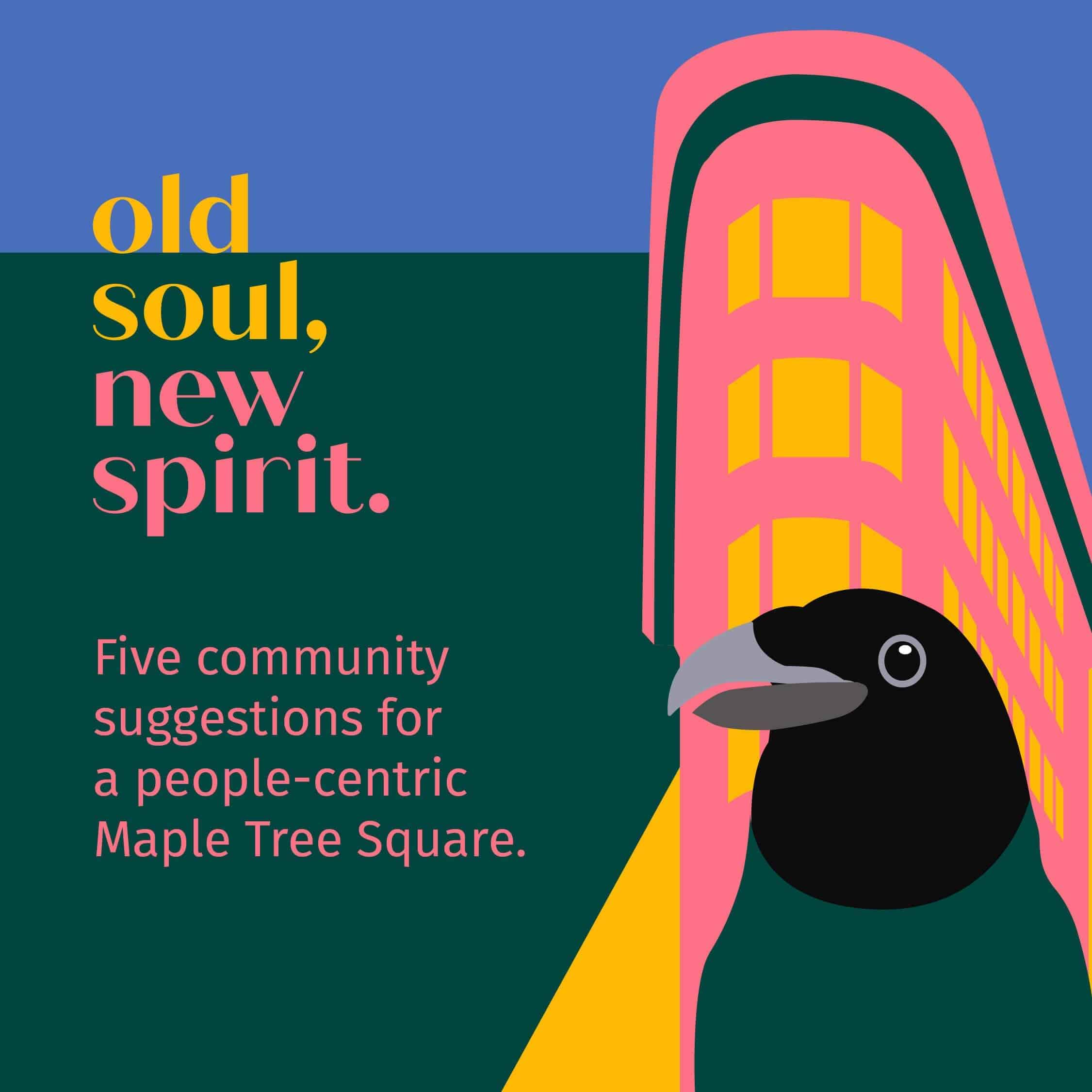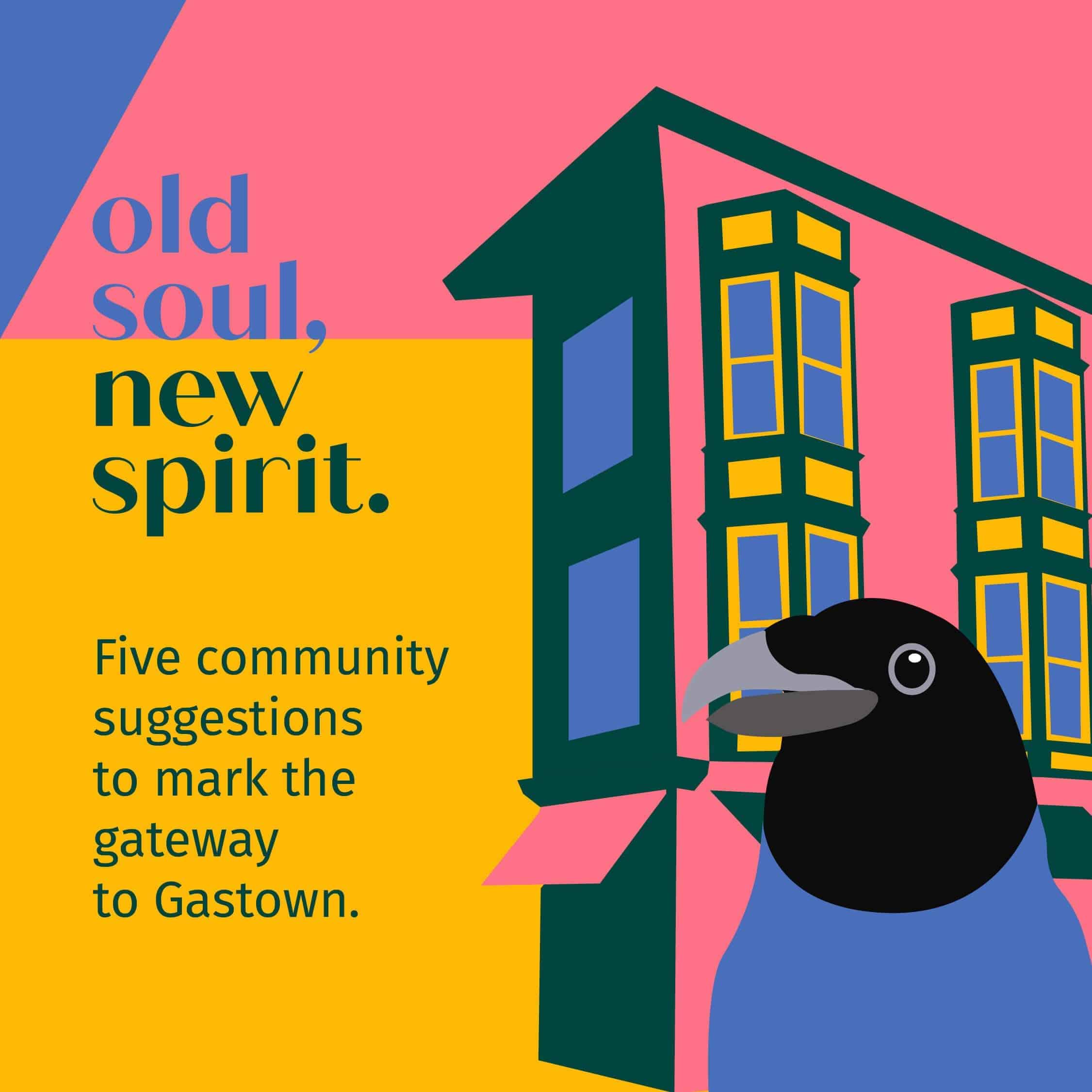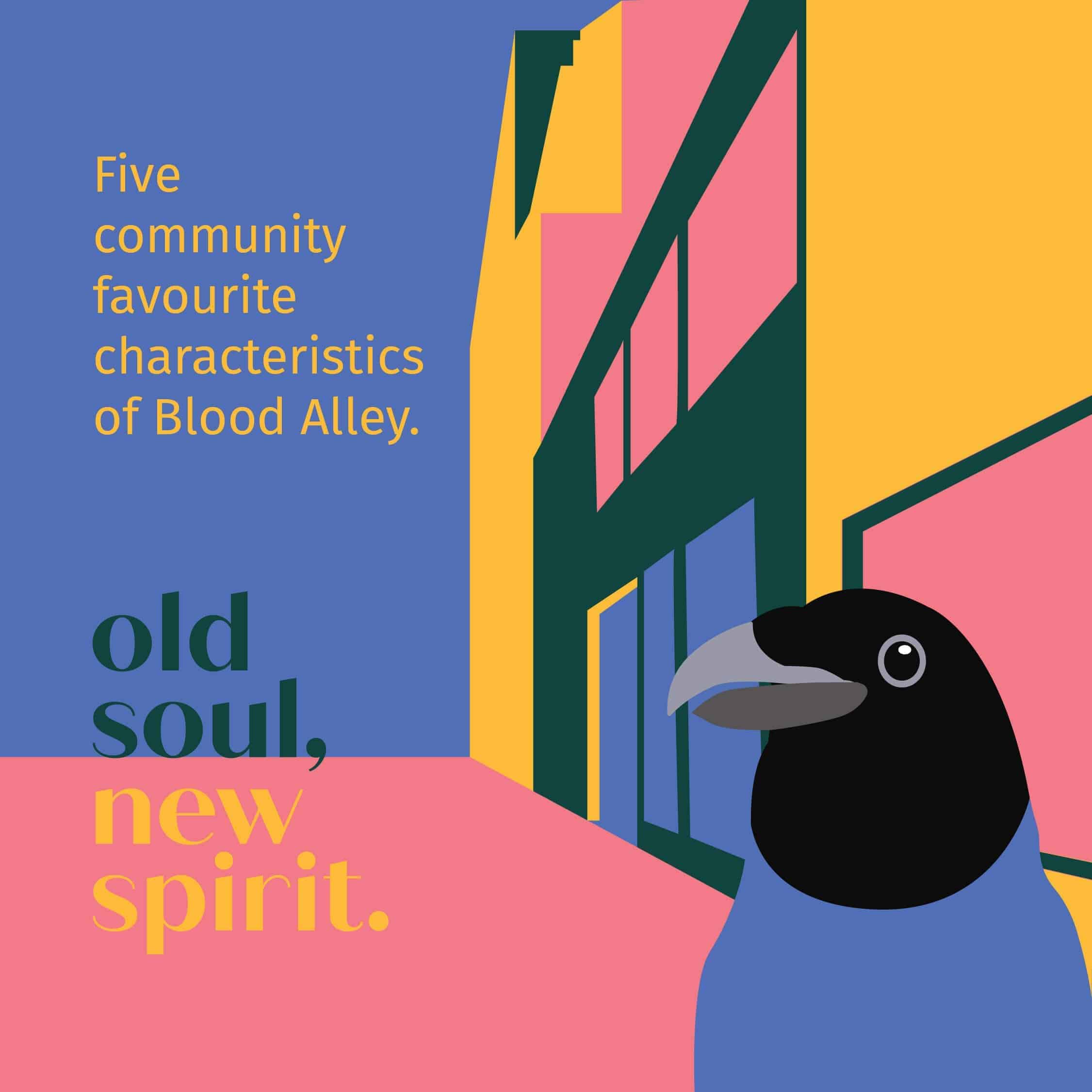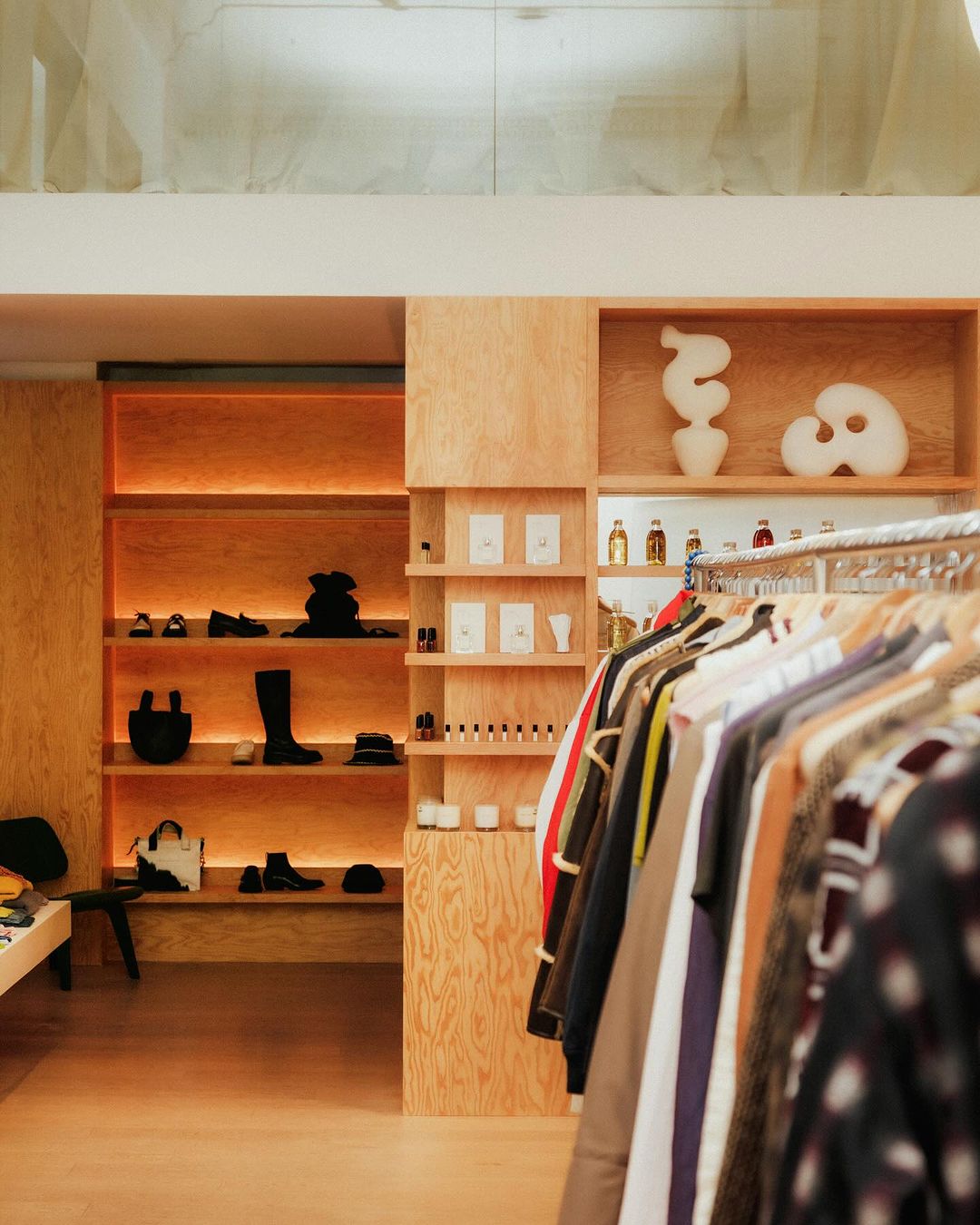
The Gastown Business Improvement Society (GBIS) released an URBAN DESIGN STUDY to provide insight into how public realm changes may affect Gastown business members, workers, residents, and visitors. This report, along with community feedback, can help shape the GBIS’s advocacy position and highlight community priorities to the City of Vancouver for focused action.
Below you’ll find a summary of the top 5 community suggestions per question.
There is still time to help shape future decision-making by sharing your visions for the Gastown of tomorrow. Fill out the survey here.
IF MAPLE TREE SQUARE COULD CHANGE FROM A CAR TO A PEOPLE-CENTRIC SPACE, WHAT ACTIVITIES WOULD YOU LIKE TO SEE?

COMMUNITY SUGGESTIONS:
- MORE PROGRAMMING– from art exhibitions to farmers markets, jazz festivals to chalk-art festivals, everyone wants to see Gastown’s main square as a lively focal point for events.
- GOOD DESIGN IS IMPORTANT – the community was aligned with their opinion that aesthetics matter. Distinct, contemporary, and in keeping with the historic vibe, it was the design of the urban space that was key: a space for community organization, discourse, and engagement with the First Nations community on what they’d like to see.
- URBAN FEATURES – Beyond the repairing of the cobblestone streets, many urban design features were suggested: public seating, a First Nations monument, covered meeting spaces and patios, community garden, kids play areas, a skateboard foundation and half-pipe, to name a few!
- PEDESTRIAN VS. CAR DEBATE – while some felt that shifting to pedestrian only would improve the vitality of the square, others thought the removal of cars would be the end of the neighbourhood.
- THINGS WE COULD DO WITHOUT – everything from cars, loud noises, gift stores, and the Gassy Jack statue, which was one of the more common pieces of feedback. Many commented that they would like to see this statue replaced with something that acknowledges the original Indigenous community.
WHAT WOULD YOU LIKE TO SEE MARK THE GATEWAY TO GASTOWN AT THE TOP OF WATER AND CORDOVA STREET?

COMMUNITY SUGGESTIONS:
- SIGNAGE: there were many recommendations for signage to depict the heritage status of the neighbourhood and pay homage to the trade industries of the past. Some felt a comprehensive map of the local shopping would also be helpful.
- ART: whether it’s commissioned art from First Nations or local artists, styles reflecting the industrial history of the neighbourhood, or modern pop-art, the request for more art in a variety of styles was a common thread.
- FOUNTAIN: many felt that fountains are a welcoming feature which encourage people to gather and take in their surroundings, and one that would increase the ambiance in Gastown in general, not just in this specific area.
- LIGHTING: the illuminated trees are a current feature of the neighbourhood that the community greatly enjoys and would like to see more of, perhaps integrated into an art installation.
- NOTHING NEEDED, JUST IMPROVEMENT OF THE EXISTING: some felt that Gastown didn’t need to be announced outright, and its allure lies in the many hidden gems and opportunity for discovery. The transition to the cobblestone streets and the shift in architecture from the surrounding neighbourhoods is a subtle clue you are entering a new and distinct area. With this, improving the existing infrastructure is a priority for many.
HOW COULD THE STREETS AND ALLEYWAYS BE DESIGNED DIFFERENTLY FOR A MORE ENJOYABLE JOURNEY TO YOUR DESTINATION?

COMMUNITY SUGGESTIONS:
- DOG FRIENDLY: from small green spaces to doggie poop bags and easy disposal, our favourite furry friends need more love!
- INCREASED LIGHTING: both for ambiance and an increased feeling of safety.
- MAINTAIN THE ORIGINAL COBBLESTONE & BRICKWORK: nobody wants to lose the original feel of the road surface, but many would like to see it be more accessible for wheelchairs and the elderly.
- BETTER GARBAGE SYSTEM: from removing bins to increasing bins, this is a well debated topic, with the common thread being that a new system is needed to better organize the garbage.
- BUSINESSES AND BEAUTIFICATION: everyone agrees that more businesses, planting, signage, and seating will enhance the experience.
WHAT ARE YOUR FAVOURITE CHARACTERISTICS OF BLOOD ALLEY, AND HOW WOULD THEY COME TO LIFE BOTH IN THE DAY AND AT NIGHT?

COMMUNITY SUGGESTIONS:
- MYSTERIOUS BUT WELCOMING: many love the way the alleyways feel like a hidden secret to explore, and referenced other cities such as Paris or San Francisco. Finding little nooks to sit, secret gardens, or pop-up shops add to the intrigue of the neighbourhood.
- MATURE TREES: three mature trees have been preserved and are treasured by the locals, as there isn’t much greenspace here currently.
- SAFETY & INCLUSIVITY: a recognition that there needs to be solutions for everyone to feel safe and welcome.
- MORE RESTAURANTS AND SHOPS: there are already three at present in Blood Alley, but people would love to see them spill into other alleys in the neighbourhood to animate the whole space.
- A SMALL CITY PARK: greenery, seating, lighting, and fountains. Instead of turning this place into a lively event space, many felt it should be a place to retreat to.
WHAT SUGGESTIONS DO YOU HAVE TO IMPROVE THE WAY YOU INTERACT WITH STOREFRONTS ALONG WATER STREET?

COMMUNITY SUGGESTIONS:
- INCREASE FEELING OF SAFETY, DECREASE VANDALISM AND OPEN DRUG USE: a diverse neighbourhood that includes people that struggle with homelessness and addictions is a complex issue. There is an ongoing request for more collaboration between the DTES community, the BIA, the City of Vancouver, and social organizations.
- MORE OUTDOOR PATIO SPACE, AWNINGS, AND SEATING: the increase of outdoor patios is a welcome addition, and because of our long rainy season, covered awnings and seating would be the next request to support more window shopping and usage of outdoor space.
- FOOD CARTS, FRESH FLOWERS, AND ART: La Creperie was mentioned as a great example of how a pop-up vendor can gather and encourage people to slow down and soak in the window displays.
- INCLUDE SHOPS THAT CATER TO THE LOCALS: less tourist focused and more catered to the needs of the residences and workforce, including suggestions such as a general store, patisserie, banks, and more independents.
- CONSULT RESIDENTS: people that live in the area have a 24/7 experience of the neighbourhood and would like to be engaged more in public realm discussions.
The pandemic has brought about a tremendous amount of change, and in times like these, it’s most important to come together and use this opportunity to help shape a community we all want to see.

DOWNLOAD THE REPORT HERE to learn more about what went into Gastown’s Urban Design Study, featured below.
This study was conducted by PH5 ARCHITECTURE, who are active advocates and members of the community and have a studio in Gastown. Their approach to develop the Urban Design Study included a workshop designed to orchestrate focused discussions, identify synergies, and consider urban design responses to public realm opportunities and challenges. The process functioned to not only collect data but to also observe and consider the qualitative nature of the neighbourhood and its guests.
The Urban Design Study uncovered some interesting information that we encourage you to explore in more detail. Gastown has a very small footprint compared to other neighbourhoods.
The majority of vehicle traffic is commuter traffic and 40% of the public realm is used for vehicular traffic on Water and Cordova Street.There are no green spaces in the Gastown BIA and Crab Park isn’t very accessible for some.These 6 places have been identified to define Gastown’s characters.There are 2189 parking spots in Gastown and 88% of visitors to Gastown arrive by public transport, walking or biking.
In addition to hearing from the general public, we also reached out to Gastown creatives, such as John Fluevog, Anna Kosturova, Ben Leavitt, Charles Guan and Jocelyn Fortier to ask them what they would like to see in our community. Each creative envisioned a key area of the neighbourhood for #GastownTomorrow.
CHECK OUT THEIR SKETCHES HERE.

Thank you for learning more about the Gastown Urban Design Study, and we encourage everyone to be a part of the change, by doing the following:
1. Sharing your thoughts, feedback, and recommendations for the future of Gastown.
2. STAYING INFORMED BY SIGNING UP TO OUR NEWSLETTER.
3. Joining the conversation on social media, follow @mygastown & #GastownTomorrow.


The Gastown Business Improvement Society (GBIS) released an Urban Design Study to provide insight into how public realm changes may affect Gastown business members, workers, residents, and visitors. This report, along with community feedback, can help shape the GBIS’s advocacy position and highlight community priorities to the City of Vancouver for focused action.
Below you’ll find a summary of the top 5 community suggestions per question.
There is still time to help shape future decision-making by sharing your visions for the Gastown of tomorrow. Fill out the survey here.
If Maple Tree Square could change from a car to a people-centric space, what activities would you like to see?
Community Suggestions:
- More programming– from art exhibitions to farmers markets, jazz festivals to chalk-art festivals, everyone wants to see Gastown’s main square as a lively focal point for events.
- Good design is important – the community was aligned with their opinion that aesthetics matter. Distinct, contemporary, and in keeping with the historic vibe, it was the design of the urban space that was key: a space for community organization, discourse, and engagement with the First Nations community on what they’d like to see.
- Urban features – Beyond the repairing of the cobblestone streets, many urban design features were suggested: public seating, a First Nations monument, covered meeting spaces and patios, community garden, kids play areas, a skateboard foundation and half-pipe, to name a few!
- Pedestrian vs. car debate – while some felt that shifting to pedestrian only would improve the vitality of the square, others thought the removal of cars would be the end of the neighbourhood.
- Things we could do without – everything from cars, loud noises, gift stores, and the Gassy Jack statue, which was one of the more common pieces of feedback. Many commented that they would like to see this statue replaced with something that acknowledges the original Indigenous community.
What would you like to see mark the gateway to Gastown at the top of Water and Cordova street?

Community Suggestions:
- Signage: there were many recommendations for signage to depict the heritage status of the neighbourhood and pay homage to the trade industries of the past. Some felt a comprehensive map of the local shopping would also be helpful.
- Art: whether it’s commissioned art from First Nations or local artists, styles reflecting the industrial history of the neighbourhood, or modern pop-art, the request for more art in a variety of styles was a common thread.
- Fountain: many felt that fountains are a welcoming feature which encourage people to gather and take in their surroundings, and one that would increase the ambiance in Gastown in general, not just in this specific area.
- Lighting: the illuminated trees are a current feature of the neighbourhood that the community greatly enjoys and would like to see more of, perhaps integrated into an art installation.
- Nothing needed, just improvement of the existing: some felt that Gastown didn’t need to be announced outright, and its allure lies in the many hidden gems and opportunity for discovery. The transition to the cobblestone streets and the shift in architecture from the surrounding neighbourhoods is a subtle clue you are entering a new and distinct area. With this, improving the existing infrastructure is a priority for many.
How could the streets and alleyways be designed differently for a more enjoyable journey to your destination?

Community Suggestions:
- Dog friendly: from small green spaces to doggie poop bags and easy disposal, our favourite furry friends need more love!
- Increased lighting: both for ambiance and an increased feeling of safety.
- Maintain the original cobblestone & brickwork: nobody wants to lose the original feel of the road surface, but many would like to see it be more accessible for wheelchairs and the elderly.
- Better garbage system: from removing bins to increasing bins, this is a well debated topic, with the common thread being that a new system is needed to better organize the garbage.
- Businesses and beautification: everyone agrees that more businesses, planting, signage, and seating will enhance the experience.
What are your favourite characteristics of Blood Alley, and how would they come to life both in the day and at night?

Community Suggestions:
- Mysterious but welcoming: many love the way the alleyways feel like a hidden secret to explore, and referenced other cities such as Paris or San Francisco. Finding little nooks to sit, secret gardens, or pop-up shops add to the intrigue of the neighbourhood.
- Mature trees: three mature trees have been preserved and are treasured by the locals, as there isn’t much greenspace here currently.
- Safety & inclusivity: a recognition that there needs to be solutions for everyone to feel safe and welcome.
- More restaurants and shops: there are already three at present in Blood Alley, but people would love to see them spill into other alleys in the neighbourhood to animate the whole space.
- A small city park: greenery, seating, lighting, and fountains. Instead of turning this place into a lively event space, many felt it should be a place to retreat to.
What suggestions do you have to improve the way you interact with storefronts along Water Street?

Community Suggestions:
- Increase feeling of safety, decrease vandalism and open drug use: a diverse neighbourhood that includes people that struggle with homelessness and addictions is a complex issue. There is an ongoing request for more collaboration between the DTES community, the BIA, the City of Vancouver, and social organizations.
- More outdoor patio space, awnings, and seating: the increase of outdoor patios is a welcome addition, and because of our long rainy season, covered awnings and seating would be the next request to support more window shopping and usage of outdoor space.
- Food carts, fresh flowers, and art: La Creperie was mentioned as a great example of how a pop-up vendor can gather and encourage people to slow down and soak in the window displays.
- Include shops that cater to the locals: less tourist focused and more catered to the needs of the residences and workforce, including suggestions such as a general store, patisserie, banks, and more independents.
- Consult residents: people that live in the area have a 24/7 experience of the neighbourhood and would like to be engaged more in public realm discussions.
The pandemic has brought about a tremendous amount of change, and in times like these, it’s most important to come together and use this opportunity to help shape a community we all want to see.

Download the report here to learn more about what went into Gastown’s Urban Design Study, featured below.
This study was conducted by ph5 architecture, who are active advocates and members of the community and have a studio in Gastown. Their approach to develop the Urban Design Study included a workshop designed to orchestrate focused discussions, identify synergies, and consider urban design responses to public realm opportunities and challenges. The process functioned to not only collect data but to also observe and consider the qualitative nature of the neighbourhood and its guests.
The Urban Design Study uncovered some interesting information that we encourage you to explore in more detail. Gastown has a very small footprint compared to other neighbourhoods.
The majority of vehicle traffic is commuter traffic and 40% of the public realm is used for vehicular traffic on Water and Cordova Street.There are no green spaces in the Gastown BIA and Crab Park isn’t very accessible for some.These 6 places have been identified to define Gastown’s characters.There are 2189 parking spots in Gastown and 88% of visitors to Gastown arrive by public transport, walking or biking.
In addition to hearing from the general public, we also reached out to Gastown creatives, such as John Fluevog, Anna Kosturova, Ben Leavitt, Charles Guan and Jocelyn Fortier to ask them what they would like to see in our community. Each creative envisioned a key area of the neighbourhood for #GastownTomorrow.
Check out their sketches here.

Thank you for learning more about the Gastown Urban Design Study, and we encourage everyone to be a part of the change, by doing the following:
1. Sharing your thoughts, feedback, and recommendations for the future of Gastown.
2. Staying informed by signing up to our newsletter.
3. Joining the conversation on social media, follow @mygastown & #GastownTomorrow.





